Boiled egg hardness tester
This article also available in Spanish
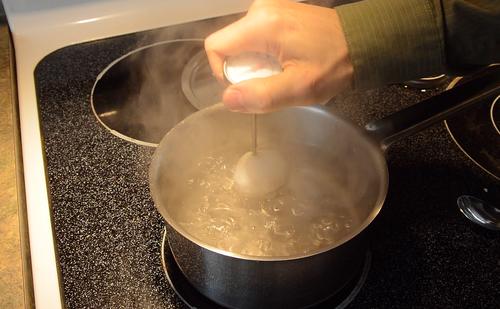 This quest started with Rachel and I eating some soft boiled eggs that
weren't quite as cooked as we thought they were. Rachel mused, if only
there was some infrared type thermometer or something that could measure
when they are done.
This quest started with Rachel and I eating some soft boiled eggs that
weren't quite as cooked as we thought they were. Rachel mused, if only
there was some infrared type thermometer or something that could measure
when they are done.
Most objects, even transparent ones, are very opaque to infrared, so I was pretty sure infrared wouldn't work. Maybe something like a meat thermometer that probes right into the egg, but then the egg would leak!
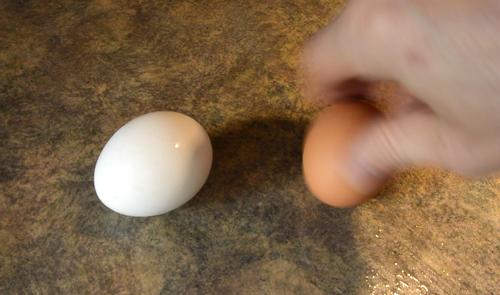
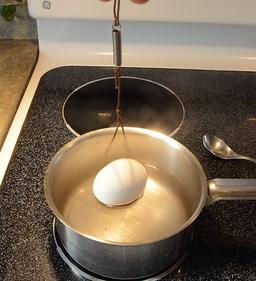 But hard boiled and raw eggs can easily be distinguished by just giving the
egg a quick spin. The hard boiled egg will spin readily. but a raw egg,
given just a quick spin, won't spin up the liquid inside, so the egg
quickly slows down to half as fast as it was spun.
But hard boiled and raw eggs can easily be distinguished by just giving the
egg a quick spin. The hard boiled egg will spin readily. but a raw egg,
given just a quick spin, won't spin up the liquid inside, so the egg
quickly slows down to half as fast as it was spun.
My first experiment was made out of #14 copper house wiring and a spring. the idea was to give it a quick jerk about a vertical axis and see how much it oscillates rotating back and forth. The raw egg stopped right away, but the hard boiled egg oscillated readily.
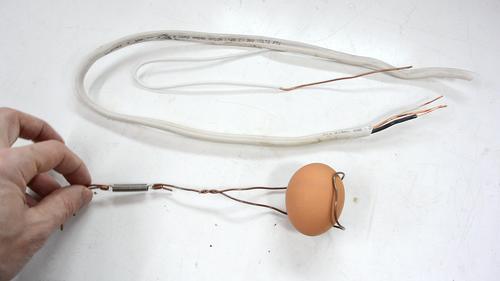 The problem with my first try was that the device couldn't
distinguish a soft boiled egg from a hard boiled. A device with a stiffer
spring and higher frequency of oscillation might be more sensitive to just
the egg's yolk still being soft.
The problem with my first try was that the device couldn't
distinguish a soft boiled egg from a hard boiled. A device with a stiffer
spring and higher frequency of oscillation might be more sensitive to just
the egg's yolk still being soft.
 So I set out to build a better device. I used stainless steel wire from a broken
whisk, a stiffer spring, and a barrier strip connector to connect them.
So I set out to build a better device. I used stainless steel wire from a broken
whisk, a stiffer spring, and a barrier strip connector to connect them.
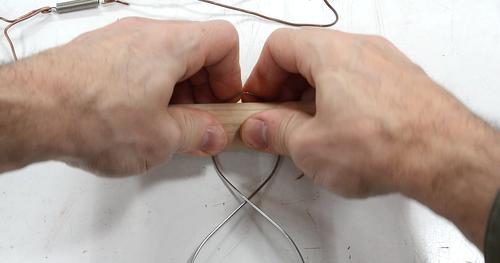
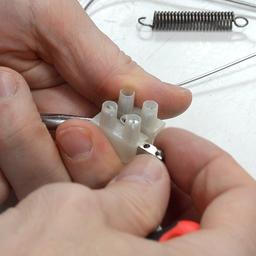 The stainless steel wire was much more challenging to bend to shape than the
copper wire.
The stainless steel wire was much more challenging to bend to shape than the
copper wire.
I took the metal part out of the barrier strip by undoing both screws and pushing the core of it out.
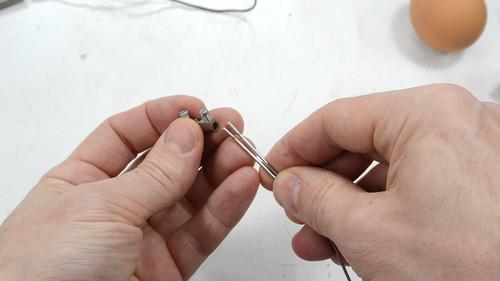 Both ends of the whisk wire just barely fit inside the barrier strip
Both ends of the whisk wire just barely fit inside the barrier strip
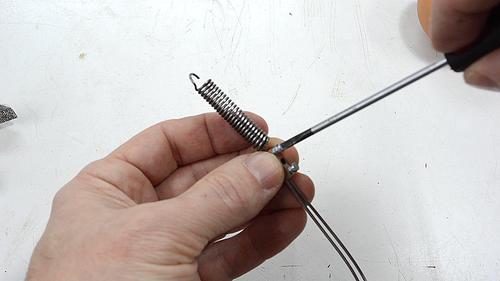
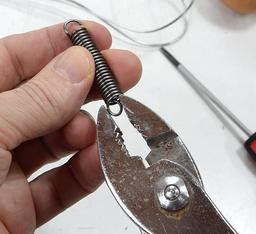 I pinched together one end of the spring so it could fit into the
screw connector on the other side.
I pinched together one end of the spring so it could fit into the
screw connector on the other side.
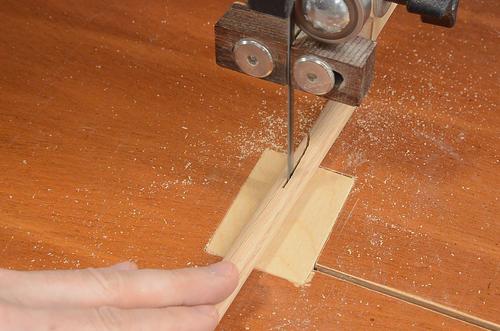
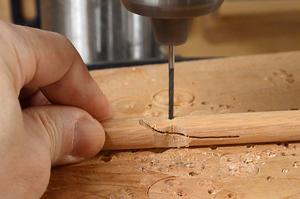 I needed a handle for the other end of the spring. I made this out of some
1/2" (12 mm) dowel, by making a cut in from the side and drilling a screw hole
to pinch the cut closed (I guess that's the only woodworking for this week!)
I needed a handle for the other end of the spring. I made this out of some
1/2" (12 mm) dowel, by making a cut in from the side and drilling a screw hole
to pinch the cut closed (I guess that's the only woodworking for this week!)
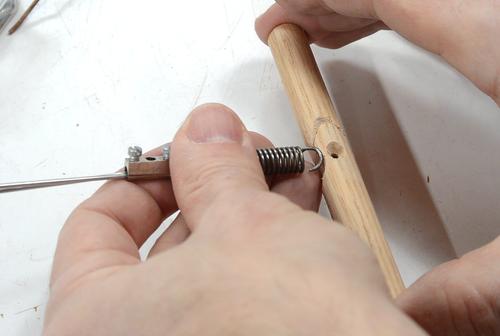
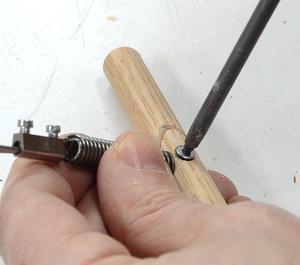 The hooked end of the spring fits in the slot, with the screw going through
the loop. The screw also squeezes the dowel around the loop for a stiff
connection.
The hooked end of the spring fits in the slot, with the screw going through
the loop. The screw also squeezes the dowel around the loop for a stiff
connection.
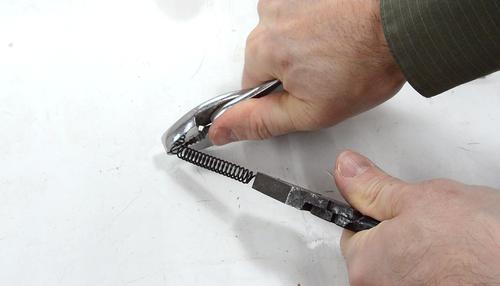
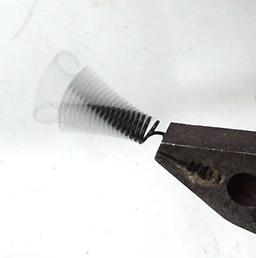 The first tests with the stiffer spring didn't work very well. I'd either need
a much tighter grip on the egg (hard to do), or a slightly slower period of oscillation.
So I grabbed another spring. This spring, like most tension springs, has the coils
tight against each other when not in tension. This causes friction as the spring
is twisted, which would dampen the oscillations. So I over-stretched the spring
until it had gaps between the coils even when it isn't stretched.
The first tests with the stiffer spring didn't work very well. I'd either need
a much tighter grip on the egg (hard to do), or a slightly slower period of oscillation.
So I grabbed another spring. This spring, like most tension springs, has the coils
tight against each other when not in tension. This causes friction as the spring
is twisted, which would dampen the oscillations. So I over-stretched the spring
until it had gaps between the coils even when it isn't stretched.
A spring like this should be able to vibrate back and forth when plucked.
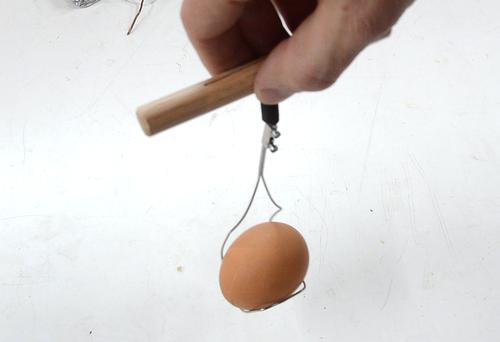 Checking with the hard boiled egg to be sure. I was glad the egg was hard boiled
because I dropped it a few times.
Checking with the hard boiled egg to be sure. I was glad the egg was hard boiled
because I dropped it a few times.
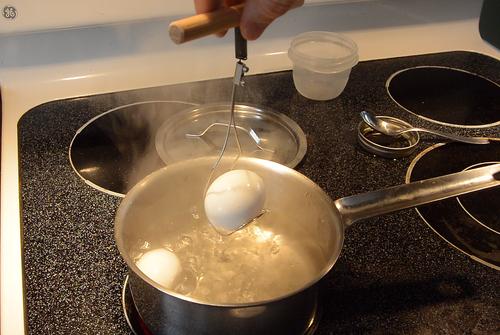 Now testing with some fresh eggs. Somewhere around five to seven minutes, it became
hard to distinguish the oscillations of the fresh egg with the hard boiled one.
Now testing with some fresh eggs. Somewhere around five to seven minutes, it became
hard to distinguish the oscillations of the fresh egg with the hard boiled one.
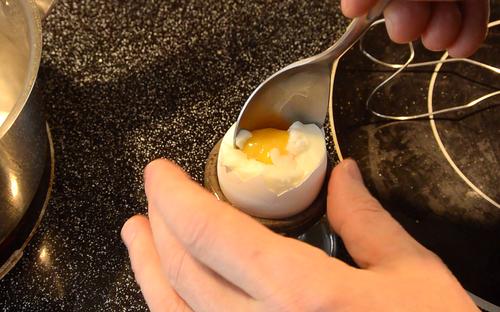 This is what the egg looked like once it became hard to distinguish from hard boiled
with my gadget. Not quite hard boiled, but quite well done for soft boiled.
Distinguishing earlier stages of boiling would be easier.
This is what the egg looked like once it became hard to distinguish from hard boiled
with my gadget. Not quite hard boiled, but quite well done for soft boiled.
Distinguishing earlier stages of boiling would be easier.
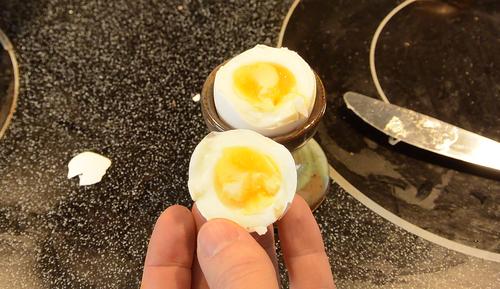 And this is how the other egg was when I really couldn't tell the difference between
it and the hardboiled one anymore. Still not quite hard boiled, though if I left the egg on the
counter for a few minutes after this, it would become completely firm inside
just from the residual heat.
And this is how the other egg was when I really couldn't tell the difference between
it and the hardboiled one anymore. Still not quite hard boiled, though if I left the egg on the
counter for a few minutes after this, it would become completely firm inside
just from the residual heat.
So my invention isn't that suitable for hard boiled eggs, but could be quite handy to tell when a soft boiled egg is about right.
Of course, I could just set a timer. But that would be too easy. I like the idea of being able to monitor the egg in progress.
More kitchen projects:
More physics related articles:
 Gyro effect explained
Gyro effect explainedwithout math
Back to my Woodworking website.
![]()
 Warp-free cutting board
Warp-free cutting board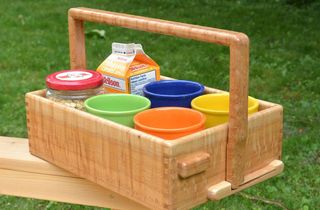 Flip handle
Flip handle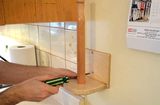 Paper towel roll holder
Paper towel roll holder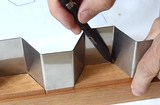 Hexagon cake knife
Hexagon cake knife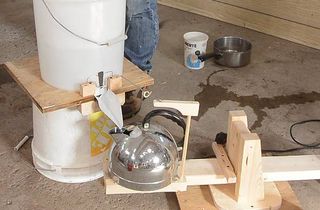 Automatic maple syrup boil-o-matic
Automatic maple syrup boil-o-matic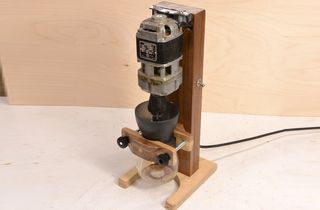 Motorizing a hand-cranked coffee grinder
Motorizing a hand-cranked coffee grinder Mini tornado experiment
Mini tornado experiment Photographing
Photographing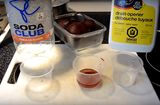 Kitchen chemistry experiment
Kitchen chemistry experiment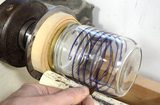 Helical glass cut experiment
Helical glass cut experiment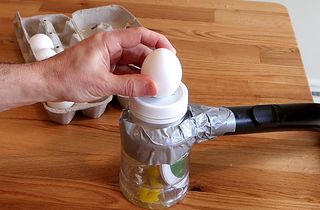 Sucking out eggs with a vacuum cleaner
Sucking out eggs with a vacuum cleaner